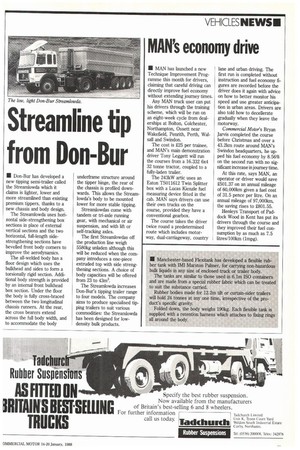MAN's economy drive
Page 13

If you've noticed an error in this article please click here to report it so we can fix it.
• MAN has launched a new Technique Improvement Programme this month for drivers, claiming that careful driving can directly improve fuel economy without extending journey times.
Any MAN truck user can put his drivers through the training scheme, which will be run on an eight-week cycle from dealerships at Bolton, Colchester, Northampton, Ossett near Wakefield, Penrith, Perth, Walsall and Swindon.
The cost is 225 per trainee, and MAN's main demonstration driver Tony Leggett will run the courses from a 16.332 6x4 32 tonne tractor, coupled to a fully-laden trailer.
The 243kW artic uses an Eaton TS011612 Twin Splitter box with a Lucas Kienzle fuel measuring device fitted in the cab. MAN says drivers can use their own trucks on the course, provided they have a conventional gearbox.
The course takes the driver twice round a predetermined route which includes motorway, dual-carriageway, country lane and urban driving. The first run is completed without instruction and fuel economy figures are recorded before the driver does it again with advice on how to better monitor his speed and use greater anticipation in urban areas. Drivers are also told how to decellerate gradually when they leave the motorway.
Commercial Motor's Bryan Jarvis completed the course before Christmas and over a 43.2km route around MAN's Swindon headquarters, he upped his fuel economy by 8.56% on the second run with no significant increase in journey time.
At this rate, says MAN, an operator or driver would save 2501.37 on an annual mileage of 60,000Icm given a fuel cost of 31.5 pence per litre. On an annual mileage of 97,000km, the saving rises to 2801.55.
Henleys Transport of Paddock Wood in Kent has put its drivers through the course and they improved their fuel consumption by as much as 7.5 litres/100Icm (1mpg).




















































































